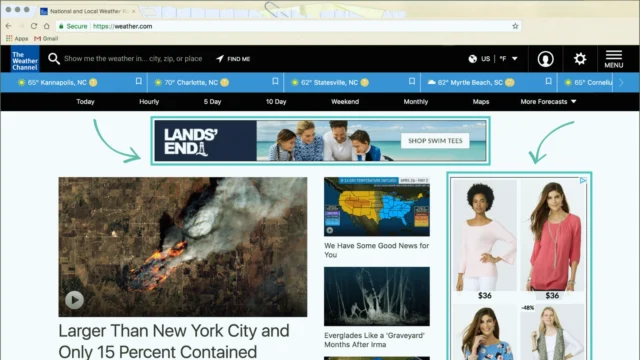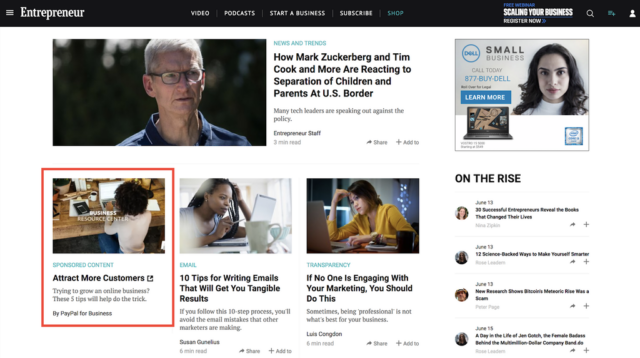
The U.S. digital advertising market is projected to reach $300 billion by 2028, with B2B marketers increasingly allocating larger portions of their budgets to digital channels to reach and engage key decision-makers.
Why? Because digital advertising is more sophisticated than ever. As marketers strive to cut through the digital noise, display ads offer a powerful way to capture attention, build brand awareness, and engage highly targeted audiences at every stage of the buying journey.
And display ad spend seems to be working:
- Marketers have boosted conversion rates by 40% or more by combining targeted audiences with display remarketing campaigns.
- After seeing a display ad, about 27% of consumers search for the business.
- When someone searches after viewing a display ad, there’s a 59% higher chance they’ll convert.

As you plan your ABM budget and ABM strategy, including display ads as a key part of your approach can help you reach, engage, and convert high-value prospects. But remember, it’s all about execution. Here are the do’s and don’ts to make your display ads stand out.
5 Steps to Build a Display Advertising Campaign
Display ads are visual ads designed to capture attention and drive ABM engagement. You’ll often see them across the internet on websites, social media platforms, and other online channels.

In account-based marketing (ABM) strategies, display ads become even more powerful by continuously exposing target accounts to the brand’s messaging across different channels, ensuring your brand stays top of mind. To help you maximize your results, we’ve outlined five key steps to building an effective ABM display advertising strategy from start to finish.
Step 1: Set Specific and Measurable Goals
What do you want to accomplish with display ads? In ABM, success isn’t just about impressions—it’s about reaching and converting the right decision-makers within your target accounts. That’s why setting clear, measurable goals is crucial.
A SMART approach (Specific, Measurable, Achievable, Relevant, and Time-bound) ensures you have a framework to create specific, actionable goals. For example, a goal can be to “Increase website traffic from target accounts by 30% within three months through display ads with a conversion rate of at least 5%.” You can change the percentages and timing around your industry benchmarks, the company’s growth stage, and historical data.
To track progress and optimize ad performance, use key performance indicators (KPIs) such as:
- Click-Through Rate (CTR): Measures how often buyers click on your ad after seeing it. A higher CTR indicates strong ad relevance and engagement.
- Viewability Rate: Tracks the percentage of your ad that is actually seen by buyers, ensuring your placements are effective.
- Conversion Rate: The percentage of buyers who take a desired action (e.g., filling out a form, requesting a demo) after clicking your ad.
- Video Completion Rate (VCR): If using video marketing ads, this metric shows the percentage of viewers who watch your ad to completion, indicating engagement and message retention.
By setting ABM-specific goals aligned with these KPIs, you can ensure your display ad strategy is driving real impact with the accounts that matter most.
Step 2: Define Target Audience
When running ABM display, your focus needs to be on reaching high-quality decision-makers within your target accounts, ensuring your ads drive engagement where it matters most.
To define your audience targeting, there are a few checklist items you’ll need:
- Intent Data: Use quality data like first-party intent data (from your website, CRM, and engagement metrics) and third-party intent data (from platforms like Madison Logic) to identify accounts actively researching solutions like yours.
- Target Account List (TAL): Define a list of prioritized accounts that marketing and sales teams focus their efforts on that will yield high engagement, conversion, and return on investment (ROI). A well-defined target account list helps marketers prioritize display ads to reach the right audience, maximizing impact and efficiency.
- Sales Collaboration: Work closely with your sales team to align on priority accounts, understand buyer personas, and refine ad messaging to address their pain points.
By narrowing your audience and focusing on intent-driven, high-value accounts, you’ll maximize the impact of your ABM display ad strategy, driving real engagement and higher conversion rates.
Step 3: Select Display Ad Channels
Once you’ve defined your target accounts, the next step is to select the right ad specs and tailor your channel to engage buyers at every stage of the funnel.
Depending on your objectives, choose ad formats that best resonate with your audience. Options include:
- Video Ads: Short interactive clips that run before, during, or after content on platforms like YouTube.
- Banner Ads: Static or animated visuals that are placed on websites.
- Native Ads: Ads designed to blend seamlessly with the content of the platform, providing a non-disruptive experience.
Each type of ad has its own benefits and use cases, making it important to choose the right format based on your marketing campaign goals and audience:

Step 4: Personalize Messaging
Personalization is key to resonating with decision-makers and staying top of mind. Your ad copy should speak directly to the specific pain points and challenges of your target accounts. Use insights gathered from both your sales teams and intent data topics to tailor ad messaging that aligns with your audience’s needs based on where your target accounts are in the buyer’s journey:
- Awareness Stage: Educate potential customers about their problems and the solutions available. Use display ads for exposure and reach.
- Consideration Stage: Provide potential customers with more detailed information about your product or service. Heavily focus on retargeting through display ads to accelerate engagement.
- Decision Stage: Provide potential customers with all the information they need to make a confident buying decision. Extend into display ads to stay top of mind.
- Retention Stage: Continue to engage with customers and provide them with the support they need to be successful with your product or service. Use display ads to share education about product attributes via videos, webinars, and trainings.
Another way to personalize your display ads is to base ads by the buying groups’ actions, such as engaging with a previous ad, visiting a landing page, or downloading a resource. Instead of showing the same generic ads, you can tailor the next ad they see to move them further down the funnel. For example:
- If a user clicks a brand awareness ad, follow up with an ad featuring a relevant case study.
- If a user views a pricing page, retarget them with a strong call to action to book a demo.
By selecting the right ad specs and personalizing your messaging at each touchpoint, you’ll create an ABM display ad strategy that nurtures your target accounts and guides them toward conversion.
Step 5: Measure and Optimize
Display is not a set-it-and-forget-it strategy. To fully maximize the impact of your ABM display ads, you need to continuously track performance, identify trends, and refine your approach using data-driven insights.
A/B testing is essential for optimizing your ABM display ads. Experiment with different headlines, visuals, CTAs, and landing pages to determine what resonates best with your target accounts. By continuously testing and refining your approach, you can improve B2B engagement, increase conversions, and ensure your ads drive meaningful impact on pipeline and revenue.
Additionally, while metrics like CTR, viewability rate, and conversion rate are important, the real value of ABM display ads goes beyond surface-level performance. Take a deep dive into account engagement to uncover hidden demand and identify which accounts are showing real buying intent. To better measure and optimize, look at things like:
- Account Engagement: Identify which target accounts are interacting with your ads, visiting key pages, or engaging with content to refine your strategy.
- Conversion Trends: Use insights from high-performing accounts, personas, and content types to double down on what’s driving conversions.
- Impact on Pipeline & Revenue: Track how display ads influence deal progression, pipeline velocity, and revenue contribution to prove ROI.
- Multi-Channel Relevance: The best account-based marketing campaigns employ a multi-channel approach. Evaluate how display ads work alongside other channels like content syndication, ABM LinkedIn ads, and CTV (connected TV) to drive engagement.
The Do’s of Display Advertising
Display advertising has the potential to drive awareness, engagement, and conversions for your B2B organization. But to truly unlock its power, you need more than just a basic understanding—you need a strategic, data-driven approach. Here’s what you should do to make your display ads as effective as possible:
Do: Define the Goals of the Campaign
It may seem simple, but many B2B marketers ignore this simple three question rule. Before launching a display campaign, take the time to clearly define your objectives and align them with your overall ABM strategy by answering these three simple questions:
- Who is your target audience? Identify the key accounts and decision-makers you want to engage.
- What are their pain points? Ensure your messaging speaks directly to their challenges and needs.
- What’s the goal, awareness or lead generation? If your objective is to increase brand awareness, display ads are a powerful ABM tool. However, if you’re focused on lead generation, display alone won’t be enough. You’ll need a multi-channel ABM strategy to nurture and convert prospects.
By setting clear goals upfront, you can tailor your display ad strategy for maximum effectiveness.
Do: Design a Custom Landing Page
Consistency is key to building trust and driving engagement. Ensure your landing pages align seamlessly with your display ads in terms of branding, imagery, and messaging. When users click an ad, they should immediately recognize they’ve landed in the right place.
For someone to share their information with you (a.k.a filling out a contact form), trust is crucial. Make it clear that there’s something valuable in return. Here’s how to build trust and encourage users to take action on your landing pages:
- Offer Valuable Marketing Content: Provide downloadable resources, case studies, or industry insights that are directly relevant to their needs.
- Keep It Simple: Keep the contact form short and straightforward. Ask for just enough information to continue the conversation, like name, email, and company.
- Create Strong Incentives: Give visitors a reason to share their details, whether it’s access to exclusive content, a demo, or a special offer.
By keeping it consistent, showing clear value and making it easy for visitors to engage, you’ll foster trust and significantly increase conversions.
Do: Have a Clear CTA
According to WordStream, a strong call to action (CTA) can increase clicks by over 371% and sales by 1,617%. Good display ads should always encourage action. If you want a click, say so clearly. Directly tell buyers what to do and what they’ll get in return.
Here are some effective B2B display ad CTA examples:
- “Request a Demo”: Perfect for showing product capabilities and engaging decision-makers
- “Download the Case Study”: Provides useful, educational content that builds trust
- “Start Your Free Trial”: Low-commitment offer that lets prospects experience your solution
- “Claim Your Exclusive Offer”: Creates a sense of urgency and exclusivity

Do: Use Data to Target Audiences
Advertising that’s served to the wrong audience is not only ineffective, but it can also be seen as intrusive. Leveraging data gets you to target the right audience, ensuring that your ads are being shown to buyers who have already expressed interest in products like yours. This approach increases relevance, enhances engagement, and ultimately drives higher conversion rates.
T-Mobile for Business partnered with Madison Logic to run ABM Display Advertising, which allowed their content to be where buyers needed it. Retargeting through display ads keeps T-Mobile for Business’ solution story relevant and persistent, with additional touches and content further down the funnel for decision-makers already engaging. Through this targeted approach, T-Mobile for Business achieved 3X and 5X increases in appointment rates for two of their key segments.
The Don’ts of Display Advertising
While display advertising can be a powerful tool for B2B marketing, there are pitfalls to avoid. Without a strategic approach, you risk wasting valuable resources and missing out on meaningful engagement. Here are the don’ts to keep in mind to ensure your display ads don’t fall short:
Don’t: Make CTR Your Definitive Metric
ABM measurement doesn’t rely on one definitive metric. Instead, focus on the bigger picture and how each metric aligns with your goals. For example, while click-through rate (CTR) is a valuable indicator of engagement, it’s not always the best measure of your display ad’s true impact in ABM campaigns.
When evaluating success, here are a few ABM KPIs to measure that bring you closer to indicating the success of your ABM display ads:
- Lead Quality: How likely the visitors coming from display ads are to convert into qualified leads or opportunities.
- Pipeline Velocity: How display ads contribute to moving target accounts through the sales funnel.
- Account Engagement: How often and how deeply target accounts are interacting with your ads, website, and ABM content. Higher engagement typically correlates with a stronger interest in your solution.
Remember, ABM success isn’t just about clicks. You need to get the right accounts to engage with your display ads and move through the buyer’s journey.
Don’t: Point Users to a Generic Page
One common mistake is using display ads to push users to a generic homepage. While you might get some clicks, those clicks are less likely to convert if the landing page doesn’t speak directly to buyers’ needs or interests. Instead of sending visitors to your homepage, send them to a page that aligns with the ad’s messaging and the specific action you want them to take.
A targeted landing page with relevant content, clear CTAs, and personalized messaging will drive better engagement and conversions. Make sure the landing page matches the offer or value proposition in the ad, so users can easily follow through on their intent.
Don’t: Cram too Much in Small Space
Most display ads are constrained to fixed sizes (e.g., 300×250, 728×90, 300×600), so you don’t have much room to work with. To maximize ad creatives, keep your message clean, simple, and to the point. Avoid cluttering the ad with too much text or too many images. Focus on delivering a clear, concise message that captures attention and communicates value quickly.
Here are the recommended ad sizes for banner, native, and video display ads:
Banner Display Ad Specs:
- Billboard: 970×250
- Smartphone Banner: 500×50 or 320×50
- Leaderboard: 728×90
- Medium Rectangle: 300×250
- Monster Mid-Page/Half Page: 300×600
Native Display Ad Specs:
- Icon: 300×300
- Main-Small: 200×200
- Main-Large: 627×1198
Video Display Ad Specs:
- In-Stream and Out-Stream Video: 1280×70
Don’t: Limit Your Reach
While ABM is all about targeting specific high-value accounts, overly narrowing your focus can mean missing out on key decision-makers or new opportunities within and beyond your target accounts. Today’s B2B buying groups are larger and more independent than ever, comprising of 6 to 10 decision-makers who may come from various roles across the organization. This could include:
- IT leaders assessing technical feasibility
- Finance executives evaluating cost and ROI
- Operations managers ensuring alignment with workflows
- Procurement teams negotiating contracts
- Marketing or sales leaders considering go-to-market impact
- End users who influence adoption and usability
By engaging a diverse group of decision-makers, you can address various concerns, demonstrate value across different functions, and build internal champions who advocate for your solution. For example, instead of focusing solely on IT decision-makers, prioritize reaching a broader set of stakeholders, including finance leaders, operations executives, and other key decision-makers who play a role in the buying process.
How Madison Logic Helps Empower Your ABM Display Advertising Efforts
When it comes to successful ABM display ad campaigns, it’s essential to follow a strategic approach that balances both the do’s and don’ts.
Display advertising is a powerful tool for building brand awareness, nurturing leads, and driving pipeline growth. Madison Logic’s ABM Display Advertising is designed to position your brand at the forefront of in-market accounts and deliver personalized messaging to active buyers where they consume content. Book a demo today to learn more about how Madison Logic can help you truly harness the power of display advertising and multi-channel ABM.



